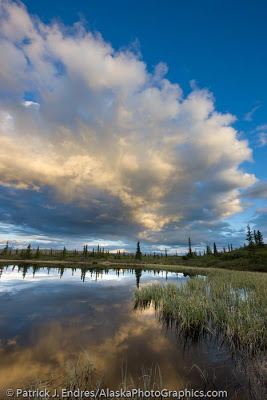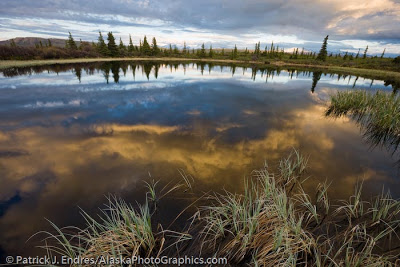 Dramatic clouds reflect in tundra pond, interior, Alaska
Dramatic clouds reflect in tundra pond, interior, AlaskaCanon 1Ds mark III, 16-35mm f2.8L, 1/15 sec @ f14, ISO 100

Clouds move with an inspiration singular to their great immensity and shape. Not only do they cast their color catching shapes across the sky in dramatic form, but they repeat themselves in the landscape on ponds, lakes and rivers. For a landscape photographer, a cloudless day provokes no excitement. It may be likened to a novel or play without conflict. The placid uniformity of blue, while consoling in some ways, does not carry the power of a tumultuous, dynamic sky. Two things to consider about a landscape photo at the close or beginning of a day:
First: look for the sky on the ground, when it is there, you may now work with reciprocating shapes and reflective colors–both strong for composition. Alaska abounds with water bodies; countless rivers, lakes and small tundra ponds give many opportunities to point your camera down yet shoot the sky.
Second: in the context of Alaska’s nightless summers, forget about sleep. I am lured by the former, but not so fond of the latter. It really does not get dark for much of the summer, depending on the latitude, and during June one could photograph for 24 hours! Capturing sunset and sunrise light means courting the midnight hours.
While on a recent photo trip–timed for the late drama of evening light–I captured these few images, which illustrate how clouds can be a critical element in a compelling landscape photo. In this case, it may be argued, they completely make the photo.






